From sea sparkles to fireflies: Chasing Australia's 'big four'
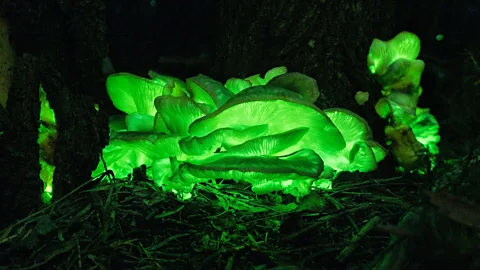
In Australia's Illawarra region, a ghostbusting-style night tour reveals ghost fungi, sea sparkles and tiny creatures lighting up the dark.
On a slate-black night, I stare at a horizon freckled with stars. Only this isn't the sky, illuminated by hundreds of constellations; it's the muddy bank of a river, charged by a colony of glow worms.
"This is my TV," says David Finlay. "It's magical, like something out of Avatar." By day, Finlay works as a transport manager, but by night, he scours Australia's bushland and beaches chasing living light. "If you're tucked up at home, you miss these things. Everybody cocoons themselves at night, whereas I think, what fun can I have?" he says.
Bioluminescent creatures lurk in many corners of the world, but Australia's Illawarra region on New South Wales' south coast is a magnet for glowing phenomena. With low light pollution, ample rainfall and high humidity, it's an ideal microclimate for these creatures to thrive and trap prey.
Many are clustered along the Illawarra Escarpment, a sweep of sandstone cliffs, fringed with forests that roll into the Pacific Ocean. "Our escarpment habitat is special. It's a well-preserved subtropical rainforest environment, which helps protect fragile bioluminescent life forms," says Finlay.
From his home in Kiama, Finlay can spot the "big four" within an hour's drive. There's sea sparkle, plankton that paints the ocean an electric blue; ghost fungi, mushrooms that radiate an eerie green; and glow worms and fireflies, which pierce the night-sky like tiny lanterns.
These natural phenomena are notoriously unpredictable and fickle to find, dictated by seasons, weather and light patterns. They are also extremely fragile, as mounting evidence shows bioluminescent creatures are waning with climate-change and human disturbance.
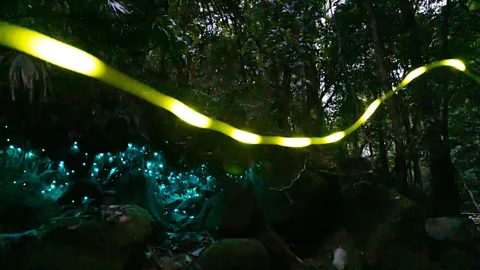 David Finlay
David FinlayBut for a growing number of glow seekers, who, like Finlay, visit with care, the challenge is part of the adventure.
When I meet Finlay at a clearing near Cascade Falls in Macquarie Pass National Park, it's only an hour past sunset, yet we're cloaked in darkness. It's Friday night, and while most people are under artificial lights, toasting to the end of the week, we're here to find natural shimmers in the night.
We trek through a path that cuts through the towering eucalypt trees, our head torches glowing red to cause minimal disturbance to wildlife. The full Moon pilots from above and the flow of the river whooshes us forward, guiding our footsteps towards the waterfall. "If something flies straight past your face, it's probably just a micro bat," warns Finlay. "They're very gentle, they're just looking for insects to eat."
Cascade Falls has an ideal microclimate for glow worms and fireflies, he explains. Glow worms aren't worms – in Australia and New Zealand, they are the larvae of fungus gnat. Elsewhere in the world, the glow often comes from beetles. They hide in wet, dark places, such as dank caves, abandoned tunnels or thick rainforest.
Glow worms are endemic to Australia and New Zealand, and while many travellers visit iconic spots like Tamborine Mountain in Queensland, there are lesser-known colonies that can be discovered if you know where to look.
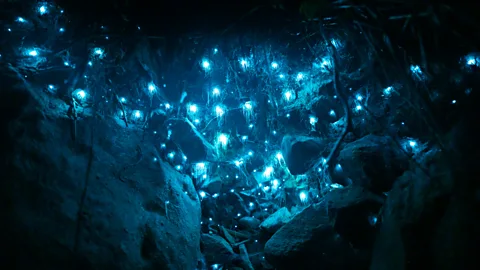 David Finlay
David FinlayAs my eyes adjust, I begin to notice more – the gnarled roots of a tree and a feathery mushroom cap. Finlay's vision is far better trained; he can easily spot silver spiders eyes blinking at us like cat's eyes on a motorway. He sweeps a UV torch across the floor, illuminating the undergrowth. A caterpillar glows fluorescent white, some lichen neon green, a leaf an aggressive shade of electric blue. "Ah, that's just possum wee," he clarifies.
Finlay runs ad hoc glow tours (when available, he posts them on his Facebook page) in the Illawarra, showing locals and visitors the spectacle that most of us overlook at night. Last year, a few hundred places on his guided walks sold in a flash – as 25,000 people vied to secure a spot.
"For a lot of people, it's like finding gold, and nobody will tell you where they find the gold," says Finlay.
But it's a delicate balance between educating visitors and conserving these habitats. "This national park is already impacted by people. I don't tell people about the really natural spots, as too many people would destroy those environments," he says.
Both fireflies and glow worms are incredibly sensitive, susceptible to habitat destruction from people, urbanisation and bush fires. The "Black Summer" bushfires of 2019-20 wiped out a "horrific" number of bioluminescent creatures, he says, with colonies impacted in national parks across Australia.
"I give people a list of dos and don'ts when they're out in the environment, and I tell them to teach other people this," says Finlay.
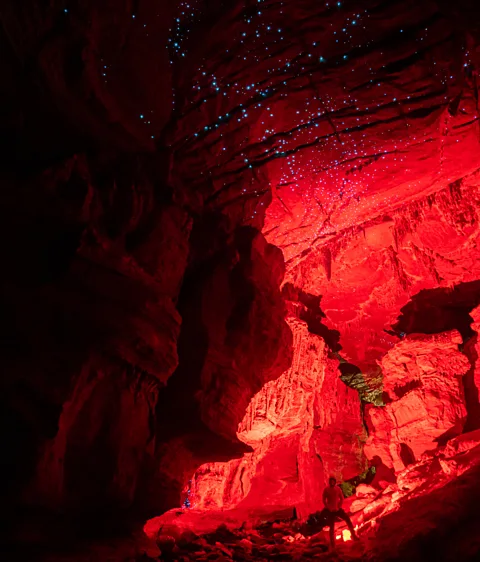 David Finlay
David FinlayA golden rule, like almost everything in the natural world, is to look but not touch. "So much as holding a glow worm in the palm of your hand will kill them," says Finlay. Bright flashing lights or even breathing too close can trigger them to shut down and disrupt their feeding patterns. We keep our voices low and hushed, and we tread carefully, making sure to move through the bush slowly.
For safety, Finlay suggests bringing a friend on a night adventure. He beams a laser pointer through the sky, tracing the kite-like constellation of the Southern Cross, in case I ever get lost and need to navigate my way south.
How to see glow worms responsibly:
We scramble down the embankment towards the mouth of the waterfall, following the tiny orbs of light. Tucked in the overhang of the river are dozens of glow worms, like a fairy grotto or twinkling Christmas light display. Up close, tendrils of silky web drip down, hanging like strings of pearls.
"Glow worms hide from sunlight, they'll crawl into nooks and crannies during the day, and when they come out at night, they have to rebuild their webs," says Finlay. Despite their beauty, these webs are death traps – snaring insects that are lured by glow-worm light.
Under the lens of the camera, the riverbank looks even more spectacular, with crystal droplets clustered around an iridescent light. It's clear why Bioluminescence Australia – a Facebook group with more than 64,000 members – has become so popular. The page was created to share photos of bioluminescent phytoplankton blooms, but it's also a message board for tracking down glowing phenomena.
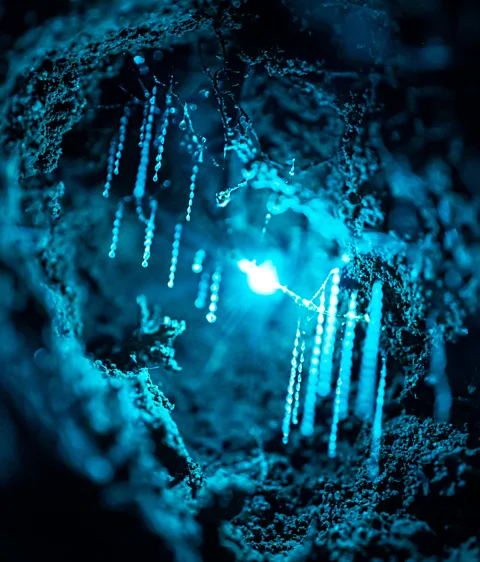 David Finlay
David FinlayGlow hunters follow a rough calendar – glow worms can generally be found year-round, whereas fireflies glimmer for a short window in Australia's late spring/summer (November to February). Elusive ghost mushrooms tend to fruit in autumn (March to May) when the temperature cools.
One of the most sought-after experiences is paddling through bioluminescence, or bio. "Everybody wants to see it, and one of the reasons is that it's so Instagrammable. You can swish your feet through it and make sparkles," says Finlay. One of the best spots to see a "blue tide" in Australia is in Jervis Bay, further along the NSW south coast, or around Hobart in Tasmania.
Christine Dean Smith is a member of the group who has photographed sea sparkles for more than a decade. "I hunt for bio because I have skin cancer and I'm banned from daylight," she says. "Being a photographer, you tend to adjust yourself to finding nighttime nature to capture instead and then I show it to my followers."
When we've spotted enough nature glowing, we retreat back through the bush to the clearing. Something flashes in my vision under Finlay's fluorescent torch – vivid, electric even; everything I've been told to keep my eyes peeled for. Maybe, I'm getting the hang of hunting for sparkles in the dark.
"Nope, just more possum wee," Finlay says.
--
If you liked this story, sign up for The Essential List newsletter – a handpicked selection of features, videos and can't-miss news, delivered to your inbox twice a week.
